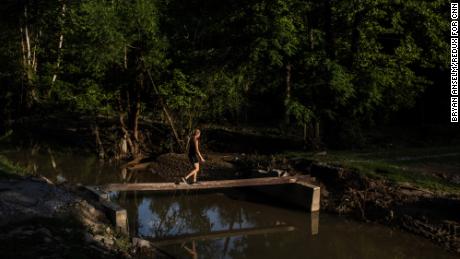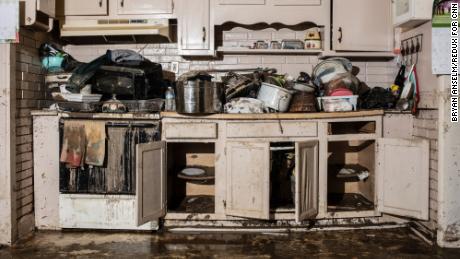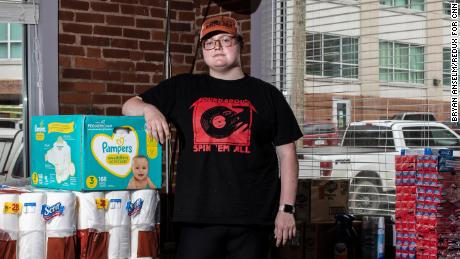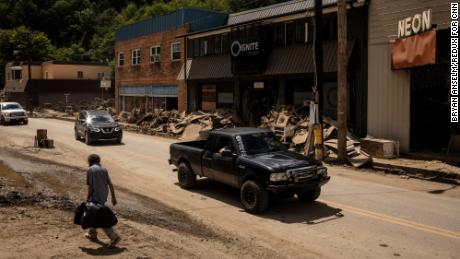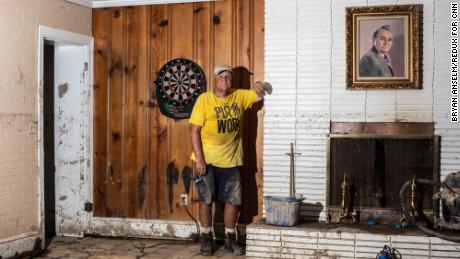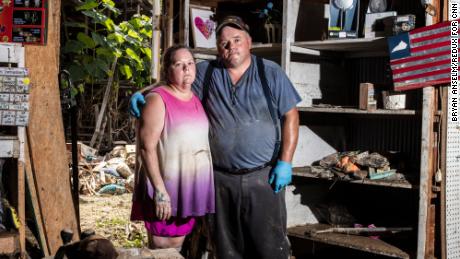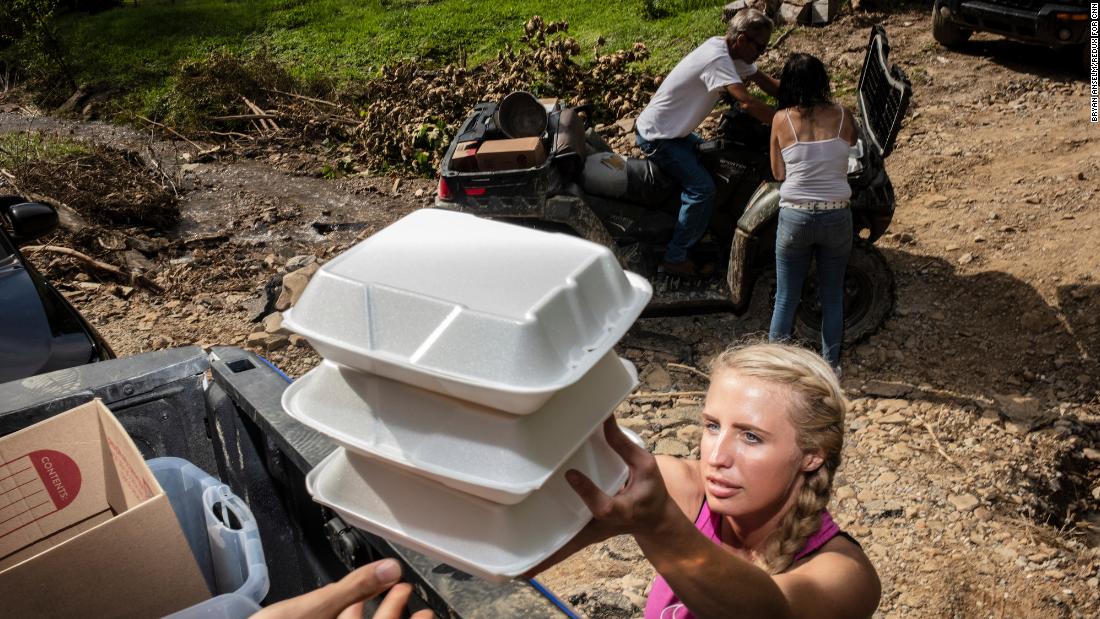
“Ya hungry?” she calls out cheerfully.
The couple is pleased to see her again. Slone has become a familiar face over the last few days, delivering scores of home-cooked meals to people in the remote reaches of Knott County. On the menu today: Sloppy Joes and corn salad.
As Slone hands over the food, she notices a disassembled bed frame and mattress sitting out front. She asks if they need it put together — her husband and a friend who are out with her today have the muscles for the job, she jokes — but the couple tells her not to worry.
She also mentions that she’s working on getting them an air-conditioning unit — she suspects the couple has been sleeping in the shed, and temperatures have been unbearably hot.
“Everybody’s come together and just done what we have to do to support each other,” she tells CNN. “That’s just what we do.”
Slone, a hairdresser whose home in nearby Littcarr was spared from the worst of the floods, says she’s fortunate that she can afford to take time off to care for more vulnerable members of her community. Many people in eastern Kentucky were already struggling when disaster struck, and the needs right now are vast and urgent.
In a region long derided and dismissed by outsiders, Slone and others in eastern Kentucky know their neighbors can’t count on support to come from elsewhere. So they’re doing what they’ve always done: Helping one another survive.
People here were already struggling
The homes and livelihoods wiped away by the flooding were already on shaky ground.
The beautiful, rugged landscape, a point of pride for the region, also presents challenges.
Eastern Kentucky is made up of hills and “hollers,” or narrow valleys cut by streams. But the steep slopes are prone to landslides, leaving the valleys vulnerable to flash flooding. Building in the hills could mitigate flood risks, but doing so is extremely costly, says Bill Haneberg.
“People have really very little choice except to live in floodplain areas,” adds Haneberg, state geologist and director of the Kentucky Geological Survey at the University of Kentucky.
As a warming planet threatens to make extreme weather events like this more common, there are concerns about how decades of coal mining and fossil fuel extraction have altered the region’s landscape.
“It’s likely we would have had extremely severe flooding even if there had never been a coal mine in eastern Kentucky,” Haneberg says. “The question that we don’t know the answer to is: How much might this amount of disturbance have increased the severity of the current floods?”
One county formed an aid network
These circumstances are part of why Slone feels so compelled to be there for her neighbors.
After a few days of cooking and delivering meals with the help of her mother and sister, she realized there were people in the community who weren’t being reached. So she enlisted some friends with off-road vehicles to go into the hollers where their truck can’t. They travel deep into these remote communities to deliver meals and cleaning supplies, asking the residents they encounter how many more houses are past them. If they have to get out of the vehicle to climb their way there, they do.
“A lot of people are stuck,” Slone says. “And there’s a lot of people that people don’t know that are stuck. We find people every day.”
Slone funded the first day of meals herself, then called for donations to keep the work going. She says she received about $800 initially, and money kept rolling in. Soon, she was getting requests for items besides food — one person needed a propane tank so their generator could keep running their medical device, another needed to borrow a side-by-side for the day.
What started as a small operation kept expanding. Another community member involved in aid efforts across Knott County reached out and asked if Slone would be willing to take the lead on addressing needs that arise in the communities of Pine Top and Caney.
Slone is now part of a team of volunteers that spans the county. Group members communicate using the walkie-talkie app Voxer, and voice messages come into the chat titled “Knott Flood” all day.
While on her route in Pine Top, Slone opens the app: A man wants to know if anyone has a trailer that can be used to haul a church parking lot’s worth of supplies. Slone responds that her husband has one that he might be able to borrow. In another voice message, she mentions that she’s trying to procure two AC units for residents in need.
Specific requests are also coming in for her designated areas, whether someone needs diapers or toothpaste.
“Even if I can’t get to it, I make sure it gets done,” Slone says.
A mutual aid group gives out cash
Others throughout the region are showing up in similar ways.
People post to the group about what they need — one man whose house was flooded needs money to pay for the motel where he and his kids are sleeping, another feels overwhelmed as he cares for elderly relatives and just needs someone to talk to. Other members of the group offer support as they are able.
The idea is solidarity, not charity, says one of the group’s administrators Misty Skaggs.
Over the last two years, EKY Mutual Aid grew from about 60 to 4,000 members, with at least half participating regularly, Skaggs says. A week-and-a-half after the floods hit, the group now exceeds 5,000 members. The numbers are relatively large for a rural region with such a small population, and Skaggs credits the community’s strength to Appalachia’s culture and history.
“When you’re struggling, you learn to struggle together a little better,” she says.
Community members are also giving out what many need most urgently: Money.
At a makeshift supply center in downtown Whitesburg, Jessica Shelton is discussing the challenges her community is up against when a woman walks in the door.
“Are you guys still handing out $200?” the woman asks. “I’ve got someone here that could use it.”
Shelton, who is organizing mutual aid efforts in Whitesburg and also works closely with EKY Mutual Aid, directs her to someone who can help. The woman walks out with the funds, no questions asked.
She says she’s personally received about $25,000 in donations to help flooding victims, nearly $10,000 of which has been distributed as direct aid. But she stresses that she’s not alone in this work — communities all over eastern Kentucky are lifting each other up.
“I know there’s people out there helping their neighbor muck out their house or lending them whatever they can,” Shelton says. “Truly everyone is doing mutual aid, whether they’re calling it that or not.”
Locals feel they’ve long been overlooked
In eastern Kentucky, caring for one’s neighbors isn’t just a benevolent gesture — it’s survival.
“One thing that we realized over the course of mutual aid is most people around here are of the mindset that the government and these institutions that we’re supposed to rely on really don’t care if poor people live or die,” says Skaggs. “And I believe that.”
That feeling of neglect runs deep in the region, resurfacing in the aftermath of the floods.
But such assistance could take time to get approved, if it gets approved at all. And for some in eastern Kentucky, these announcements are just a drop in the bucket for what’s truly needed to address the challenges facing the region.
“We had a housing crisis before this flood. We’ve had environmental crises before this flood,” Shelton says. “No one that has any power to do anything has been doing anything about it — no matter how much we scream about it.”
Others, like fourth-generation Fleming-Neon resident Sam Quillen, are skeptical, too. He would have liked to see some kind of federal presence sooner, and he’s unsure whether the funding that will ultimately be approved will be enough for his town to recover.
“We’re kind of on the end of the spectrum of getting anything,” he says. “And that’s the way we’ve always been treated. We don’t have enough population to warrant enough clout.”
Barely a week after the disaster, Quillen and others say it feels like national attention is already fading.
But many are committed to staying
As Crystal Watson surveys what’s left of the Isom Vendors Mall and Flea Market, she wonders how her business — and the region — will recover.
People came to the indoor antique mall in Letcher County from surrounding counties to score discounted appliances, furniture and other items. With few other economic opportunities in the area, the market that she and her husband owned for seven years also kept many of her vendors afloat.
The floods wiped out thousands of dollars in inventory, as well as entire livelihoods, Watson says. A 96-year-old woman at the market worked here for extra income, while a couple in between jobs relied on it to make ends meet.
Watson, her staff members and some friends have been working since last week to remove the mud that cakes the floor. While the destruction of the place where she spent so many of her waking hours is hard to stomach, she knows many people have it much worse. So she’s doing her best to reopen.
“This is a needed thing for this area, because people can’t afford new,” Watson says. “Everybody’s on fixed incomes or they’re elderly. They need this stuff.”
Others are coming to a different conclusion. In Quillen’s town of Fleming-Neon, a few elderly business owners have already told him that they don’t plan on reopening. Rebuilding will take time and money that they don’t have, and they’re better off relocating.
But plenty see the potential in eastern Kentucky, and are pushing for a better future.
Years ago, Slone moved for a time to Morgantown, West Virginia. It wasn’t home, though, and she soon returned.
“I missed the ‘What are you putting in your pot roast?’ in the grocery store, and ‘How’s your mom?'” she says. “This is where you want to be when something happens.”
Slone doesn’t know how long she’ll be cooking meals and delivering supplies to her neighbors. But as long as there’s a need, she says she’ll be out there — showing up for the people who make this beautiful, complicated region worth it.
